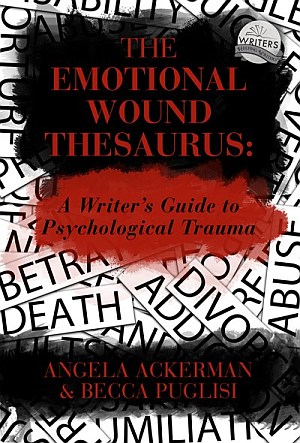The Thesaurus books by Angela Ackerman and Becca Puglisi are a must-have for every fiction author. I’ve raved many times about the awesomeness of their Emotion Thesaurus and how we can use it to improve our writing.
We’ve also had Becca here before to talk about some of their other Thesaurus books. During her visits, Becca’s shared seven tips for using the Trait Thesauri and four tips for using the Setting Thesauri books.
Now, I’m excited to bring Becca back with insights from their latest book, The Emotional Wound Thesaurus: A Writer’s Guide to Psychological Trauma. Woo hoo!
We all love a “good” villain—one who’s creepy, evil, interesting, or near-impossible for our hero to overcome—but sometimes we want our bad guy to see the light and find redemption (or at least start on that path). Seem impossible to write that believably? Becca’s going to show us how with four paths to redemption for our villain.
Please welcome Becca Puglisi! *smile*
*****
The Author’s Guide to Redeeming Villains
by Becca Puglisi
Have you ever fallen in love with a story villain? Or at least found yourself liking him or her somewhat against your will? Seems a little weird, experiencing the happy feels for the bad guy, but I think we’ve all been there.
When a villain is well written and well rounded, they can tug at our heartstrings just like the protagonists do—which can be cruel, since the villain is usually destined to fail. I say usually because stories can include a change of heart for the antagonist.
Is this what you’d like for your bad guy or girl? Let’s take a peek at the villain’s journey and see what the path to redemption might look like.
Understanding Character Arcs: Positive Arcs
First, we need to have a basic understanding of character arc. In essence, this is the transformation a character goes through from the start of the story to the finish.
In the opening pages, the character is lacking something internally. Often, this comes out of a wounding event from the past—a trauma that was so scarring, she was compelled to don emotional shielding to protect herself from the pain of that experience and any possible recurrence.
This emotional shielding comes in the form of bad habits, defense mechanisms, personality flaws, biases, and skewed beliefs that, while intended to protect the character, only create more problems. They’re so destructive that they create a void in the area of her basic human needs.
This void leads her to pursue a story goal (outer motivation) that will fill that need. But her emotional shielding cripples her, keeping her from succeeding and becoming fully realized.
Throughout the course of her story, the character recognizes those internal problems and begins to address and change them. This enables her to grow and deal properly with her past, eventually ensuring that she meets her goal and achieves fulfillment.
Understanding Character Arcs: Negative Arcs
That transformation is the essence of a change arc. It’s the one most protagonists follow. But there’s another, lesser-used arc form: the failed arc.
Villains usually have a “negative character arc”—but can they be redeemed? Click To TweetHere, the character is unable to overcome their issues and the demons of the past, failing to make the necessary positive changes that would enable them to achieve their goal and fill their inner void. Characters following this arc end the story either back where they started or worse off than they were to begin with.
Very often, this is where you’ll find the villain in your story. She may be aware of the wounding event from her past, but she’s already tried to deal with it and has failed.
Now she’s embracing her dysfunctional behaviors, believing they’ll make her stronger. Or she may never have faced her past and is living in denial, refusing to address it.
Either way, she’s destined to continue living an unfulfilled life that lacks closure—unless she’s given the opportunity to try again, and this time, succeed. Then…redemption.
How Can We Redeem Our Villain?
So as an author interested in redeeming your villain, you first must know her backstory, which will tell you what she’ll have to overcome to succeed.
- What wounding event from the past profoundly impacted her?
- How did her view of herself or the world change because of it?
- What new behaviors, beliefs, habits, and responses developed as a means of protecting herself from a recurrence of that event and the negative emotions associated with it?
There’s a lot of backstory to explore, but questions like these will get you started. We’ve even created a handy questionnaire to help you dig into this area of your character’s past.
Once you’ve got a clear vision of your villain’s history, you can use one of the following techniques to get her back on the road to healing.
Redemption Path #1: Elevate the Stakes Associated with Unmet Need
Need is a primary motivator for all people. A void in the human needs department will push the character to take action to alleviate it; this typically means facing past pain and becoming vulnerable again.
But a villain won’t want to go there. Instead, she denies or avoids her past, distracting herself by pursuing other goals and interests.
To turn her around, poke that sore spot; make that unmet need really hard to ignore. Create a situation that makes her painfully aware of her lack and forces her to reconsider her position.
Need to redeem your story's villain? 4 paths they can take... Click To TweetAs an example, look at Darth Vader—the ultimate villain redemption story. He’s as dysfunctional as they come, cut off emotionally from others. Then, he meets his son.
Over the course of several clashes and conversations, something shifts in him, until he eventually chooses his relationship with Luke over everything else.
Figure out which of your villain’s unmet needs (there are probably several) is the most vulnerable, and create a scenario that amplifies it, making it a problem she must address.
Redemption Path #2: Reveal the Truth about Chosen Story Goal
As we’ve discussed, outer motivations are chosen as a means of filling an unmet need. While most characters aren’t aware of their inner-need void, they subconsciously believe that achieving a certain goal will bring them happiness and completion, so they pursue it.
For instance, someone living without love may begin a journey to find a soul mate, or a character lacking esteem might seek to prove himself by winning a competition or contest.
But self-awareness isn’t a common trait for villains. They’re incredibly unfulfilled, and they’ll avoid like the plague any emotions or circumstances that mirror their past pain.
So your villain will choose goals that look promising but won’t ultimately satisfy. Avenging herself, amassing vast amounts of wealth and material goods, being feared by others—motivations like these won’t fill the inner void.
If she can be led to a place where she recognizes this unending spiral of pursuing goals, achieving them, and still being unable to escape her pain, she may become motivated to look at other options, including facing the source of her trouble.
This is hard to do, since she’s set in her ways and her actions over time have piled up, making it very difficult for her to examine herself realistically. This process of self-realization can be encouraged with the help of a friend, associate, or even an enemy who is able to hold up a mirror that reveals the villain’s true reflection.
Redemption Path #3: Show How to Forgive
In the aftermath of a wounding event, it’s normal to examine it and try to figure out what went wrong.
Very often in this process, the character will end up blaming someone else (a person, group of people, organization, system, etc.) or finding fault with herself—even if no one is to blame. Unwilling to face the truth, she dedicates herself to punishing those at fault, believing it will ease her pain.
To turn this villain around, you must force her to see that her blame is misplaced and lead her to a place of forgiveness. Create a new scenario where the source of the villain’s blame proves to be upright or somehow bucks her stereotype.
Allow a respected person in the villain’s life to forgive in extreme circumstances, undermining her beliefs about what true strength and weakness look like. This could also be achieved if one of the villain’s victims chose to forgive her. Scenarios like these can shine a new light on her long-held beliefs and ideals about forgiveness, stimulating change.
Redemption Path #4: Recreate the Wounding Event
If your villain is unwilling to examine the trauma from her past, recreate it so she’s forced to deal with it—but provide a different outcome:
- Maybe, this time, she can see that her blame was misplaced.
- Perhaps the dysfunctional habits she’s embraced (her perceived strengths) fail to protect her, and she realizes that they’ve been holding her back all these years.
- She might look at her own enemy and see similarities to herself, causing her to question everything that has happened since that fateful first meeting.
Final Tip for Redemption: Change Is Hard
Obviously, none of this happens quickly. Change takes time—particularly for someone so ingrained in their habits and false beliefs.
For the conversion to ring true, your villain will need numerous chances to change. Build them into your story while the protagonist is undergoing his own transformation. Give the villain ample opportunities to examine her trajectory and reconsider her path.
These scenarios should trigger deep and unexpected emotions that eventually lead to a change of heart. Redemption for these characters usually requires some form of self-sacrifice as a way of making amends that often (but not always) results in their demise.
How your villain ends their story is up to you, but with these techniques, redemption is always an option.
*****
 Becca Puglisi is an international speaker, writing coach, and bestselling author of The Emotion Thesaurus and its sequels, including The Emotional Wound Thesaurus: A Writer’s Guide to Psychological Trauma.
Becca Puglisi is an international speaker, writing coach, and bestselling author of The Emotion Thesaurus and its sequels, including The Emotional Wound Thesaurus: A Writer’s Guide to Psychological Trauma.
She is passionate about learning and sharing her knowledge with others through her Writers Helping Writers blog and via One Stop For Writers—a powerhouse online library filled with description and brainstorming tools to help writers elevate their storytelling. You can find Becca online at both of these spots, as well as on Facebook and Twitter.
*****
About The Emotional Wound Thesaurus:
Identifying the backstory wound is crucial to understanding how it will shape your character’s behavior, and The Emotional Wound Thesaurus can help. Inside, you’ll find:
- A database of traumatic situations and events common to the human experience
- An in-depth study on a wound’s impact, including the fears, lies, personality shifts, and dysfunctional behaviors that can arise from different types of trauma
- An extensive analysis of character arc and how the wound and any resulting unmet needs fit into it
- Techniques on how to show the past experience to readers in a way that is both engaging and revelatory while avoiding the pitfalls of info dumps and telling
- A showcase of popular characters and how their traumatic experiences reshaped them, leading to very specific story goals
- A Backstory Wound Profile tool that will enable you to document your characters’ negative past experiences and their aftereffects
Root your characters in reality by giving them an authentic wound that causes difficulties and prompts them to strive for inner growth to overcome it. With its easy-to-read format and over 100 entries packed with information, The Emotional Wound Thesaurus is a crash course in psychology for creating characters that feel real to readers.
Amazon | Kindle | Barnes & Noble | Apple | Kobo | PDF version
(other purchasing options)
*****
Thank you, Becca! I love seeing all these options for how to include our villain and their arc in our story.
Many popular stories—from Disney movies to superhero films—emphasize the heroes’ success by tossing the villain off a cliff or other horrible fate. But that’s not the right ending note for every story.
Depending on the theme of our story, we might want our villain to die a horrible death (i.e., don’t be like that guy) or recognize the power of goodness (e.g., love/hope is stronger than hate)—or anything in between. Some themes require redemption endings to strengthen our message, and other themes need the opposite.
By understanding the arc of our villain and our options for wrapping up their arc, we can make the right choices for our story—no matter what ending our villain deserves. *smile*
Do you think villains can be redeemed? If you’ve read stories with believable redeemed villains, what made their redemption work for you? Do any of your stories need a more positive ending for your villain? Will this post help you create the right ending for your story? Do you have any questions for Becca?


